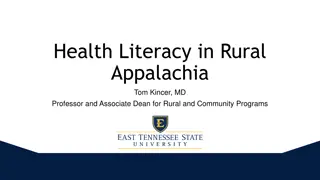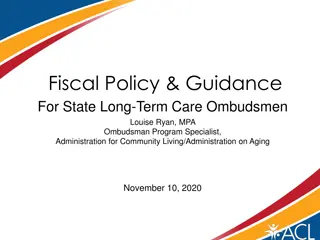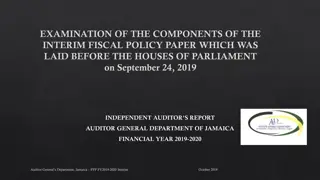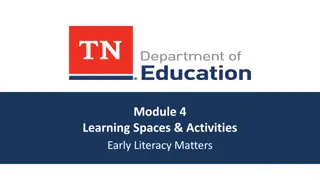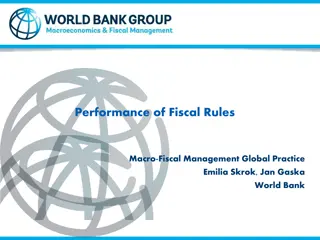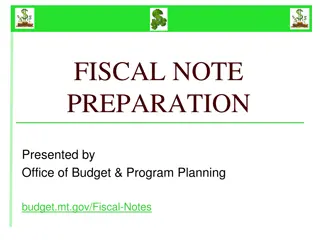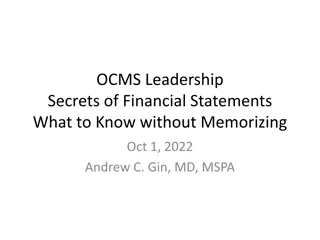Enhancing Fiscal Literacy and Financial Leadership Skills
In this presentation, participants will grasp the concept of fiscal literacy, understand the importance of financial leadership, learn to manage business operations through an operating statement, create departmental budgets, conduct variance analyses, and more. Being a competent leader involves effectively communicating financial matters and blending clinical and financial issues. It emphasizes developing a robust understanding of financial terms, reports, and processes, assembling the right team, and fostering collaboration within the department. The presentation underscores the significance of core financial statements in evaluating a company's operating performance.
Download Presentation

Please find below an Image/Link to download the presentation.
The content on the website is provided AS IS for your information and personal use only. It may not be sold, licensed, or shared on other websites without obtaining consent from the author.If you encounter any issues during the download, it is possible that the publisher has removed the file from their server.
You are allowed to download the files provided on this website for personal or commercial use, subject to the condition that they are used lawfully. All files are the property of their respective owners.
The content on the website is provided AS IS for your information and personal use only. It may not be sold, licensed, or shared on other websites without obtaining consent from the author.
E N D
Presentation Transcript
By the end of this presentation you will be able to: Define Fiscal Literacy & understand why it is necessary to be a leader Recognize the components of an operating statement & utilize to manage your business Create a departmental budget Interactive budget exercise Complete a variance analysis Interactive variance exercise
Fiscal Literacy is defined as: Possessing the skills and knowledge on financial matters to confidently take effective action that best fulfills an individual s goals
A good leader understands daily operations and the impact of decisions on financial performance Leaders need to be able to effectively communicate financial issues of an entity
A good leader should be able to successfully tell the story of their department/entity by weaving together the clinical (provider, patient, quality) AND financial issues
Is there an APP on my IPhone? Should I go back to college?
Develop a good working knowledge of key financial terms, reports & processes Put together the right team You don t need to be a subject matter expert You should, however, know what to look for It s important to know what type of questions to ask Go to subject matter experts for help! Collaborate & communicate within the department Physician lead, Administrative & Finance Leads all working together, leveraging the different skill sets
Core financial statement Presents a company s operating results over a specific period of time Starts with revenue and then subtracts expenses to calculate net income Sometimes referred to as an income statement, a P&L (profit & loss), statement of operations, earnings report
Required by Regulatory Agencies, Banks, etc. Provides a uniform and understandable mechanism for measuring financial performance To monitor financial results Over the passage of time; allows for comparison to previous periods Vs a Budget
Revenues inflows resulting from the provision of goods and services Actual REVENUES
Actual In a hospital, Gross Revenue is generally services provide to the patient (charges) REVENUES Gross Revenue $1,000,000
Actual REVENUES Gross Revenue $1,000,000 Less Deductions: Uncompensated Care Bad Debt Contractuals Total Deductions There are reductions made that reduce the amount of gross charges 10,000 5,000 600,000 615,000 Uncompensated Care Revenue that will not be collected because the patient qualified for discount under the charity care policy; patient deemed unable to pay Bad Debt Contractuals Revenue that will not be collected due to contractual agreements with payors Revenue that will not be collected due to patients unwillingness to pay
$1.0 M Gross Charges MEDICARE $0.30M Gross 30% The resulting percentages of the total charges is referred to as the payor mix MEDICAID $0.20M Gross 20% COMMERCIAL $0.50M Gross 50%
Contractual Adjustment % Contractual Adjustment $ Net Realization Rate MEDICARE Gross Revenue 75% $0.23M $0.07M 25% $0.30M MEDICAID 80% $0.16M $0.04M 20% $0.20M COMMERCIAL 45% $0.23M $0.27M 55% $0.50M
Actual REVENUES Gross Revenue $1,000,000 Less Deductions: Uncompensated Care Bad Debt Contractuals Total Deductions 10,000 5,000 600,000 615,000 Net Revenue is the Gross Revenue less deductions. This is the real amount expected to be collected Net Revenue 385,000
Actual REVENUES Gross Revenue $1,000,000 Less Deductions: Uncompensated Care Bad Debt Contractuals Total Deductions 10,000 5,000 600,000 615,000 Net Revenue 385,000 EXPENSES Salary Expense Supply Expense Other Expense Total Expenses Expenses are outflows resulting from the acquisition of goods and services 150,000 75,000 50,000 275,000
Variable- costs move up and down dependent upon changes in volume Fixed- costs consistent regardless of changes in volume Step Variable- costs remain consistent, but do change at certain discrete changes in volume
Assumption - One tech with appropriate equipment can do 250,000 tests annually Assumption - Salary and associated costs for one tech - $80,000 Perform 1 test 1 Tech required $80,000 Expense Perform 250,000 tests 1 Tech required $80,000 Expense At this point, the tech appears to be a fixed expense
The $80,000 cost remained fixed, until we reached a discreet change in volume. At that point, our expenses went up. Perform 250,001 tests 2 Techs required $160,000 Expense
Actual REVENUES Gross Revenue $1,000,000 Less Deductions: Uncompensated Care Bad Debt Contractuals Total Deductions 10,000 5,000 600,000 615,000 Net Revenue 385,000 EXPENSES Salary Expense Supply Expense Other Expense Total Expenses 150,000 75,000 50,000 275,000 EBIDA is earnings before interest, depreciation and amortization. Subtotal that measures cash earnings from operations EBIDA 110,000
Actual REVENUES Gross Revenue $1,000,000 Less Deductions: Uncompensated Care Bad Debt Contractuals Total Deductions 10,000 5,000 600,000 615,000 Net Revenue 385,000 EXPENSES Salary Expense Supply Expense Other Expense Total Expenses 150,000 75,000 50,000 275,000 EBIDA 110,000 Depreciation is the allocation of fixed assets over their useful lives Less: Depreciation 7,500
Actual REVENUES Gross Revenue $1,000,000 Less Deductions: Uncompensated Care Bad Debt Contractuals Total Deductions 10,000 5,000 600,000 615,000 Net Revenue 385,000 EXPENSES Salary Expense Supply Expense Other Expense Total Expenses 150,000 75,000 50,000 275,000 EBIDA 110,000 Total Operating Revenues less Total Operating Expenses Less: Depreciation 7,500 Operating Income $102,500
Actual Budget Variance REVENUES Gross Revenue $1,000,000 An operating statement typically displays the actual results for the period, along with the corresponding budget and variances Less Deductions: Uncompensated Care Bad Debt Contractuals Total Deductions 10,000 5,000 600,000 615,000 Net Revenue 385,000 EXPENSES Salary Expense Supply Expense Other Expense Total Expenses 150,000 75,000 50,000 275,000 EBIDA 110,000 Less: Depreciation 7,500 Operating Income $102,500
A revenue and expense forecast describing an entity s financial goals The estimates for each line item reflect what management wants and expects to achieve in upcoming periods BUT WHY???
Assists in making sure goals are met Capital Debt Pension Funding Etc. Accountability of management Can help control spending Helps with allocation of limited resources Can use to control direction of company
Payor Mix Assumptions Patient population/ demographics Shifts in payor mix Changes in reimbursement rates Revenue Assumptions Volume projections Changes to chargemaster Inpatient vs. Outpatient mix Types of procedures, tests Full Time Equivalent (FTE)- A standard measure of full-time work. Often measured as 40 Staffing/Salary Assumptions # of FTE s necessary to support volumes Appropriate skill mix Fixed vs. variable Merit Increases Other Expense Assumptions Level of expenses needed to support volumes Fixed vs. variable Medical vs. non-medical Inflation hours per week/2,o80 per year
For Step #1, were going to build a budget.. Refer to your handout for assumptions Using the assumptions, calculate out the values for each line item, and transfer them to the budget column of the worksheet We ll take about 10 minutes to complete ..
Budget REVENUES Gross Revenue
Budget REVENUES Gross Revenue Quantity 10,000 5,000 15,000 Charge Per Gross Revenue $750,000 $250,000 $1,000,000 $1,000,000 CPT #1 CPT #2 $75 $50
Budget REVENUES Gross Revenue $1,000,000 Less Deductions: Uncompensated Care Bad Debt
Budget REVENUES Gross Revenue $1,000,000 Less Deductions: Uncompensated Care Bad Debt Percent Gross Revenue Deduction 3.0% $1,000,000 2.0% $1,000,000 30,000 20,000 Uncompensated Care Bad Debt $30,000 $20,000
Budget REVENUES Gross Revenue $1,000,000 Less Deductions: Uncompensated Care Bad Debt Contractuals 30,000 20,000
Budget REVENUES Gross Revenue $1,000,000 Less Deductions: Uncompensated Care Bad Debt Contractuals Payor Mix 30% 20% 50% Gross Revenue $300,000 $200,000 $500,000 $1,000,000 Contractual % Contractual Adj. $219,000 $154,000 $200,000 $573,000 30,000 20,000 573,000 Medicare Medicaid Commercial 73% 77% 40%
Budget REVENUES Gross Revenue $1,000,000 Less Deductions: Uncompensated Care Bad Debt Contractuals Total Deductions 30,000 20,000 573,000 623,000 Net Revenue 377,000 EXPENSES Salary Expense
Budget REVENUES Gross Revenue $1,000,000 Less Deductions: Uncompensated Care Bad Debt Contractuals Total Deductions 30,000 20,000 573,000 623,000 Net Revenue 377,000 FTEs Salary Per $150,000 $40,000 Salary Expense $150,000 $120,000 $270,000 EXPENSES Salary Expense Staff Non-Staff 1 3 4 270,000
Budget REVENUES Gross Revenue $1,000,000 Less Deductions: Uncompensated Care Bad Debt Contractuals Total Deductions 30,000 20,000 573,000 623,000 Net Revenue 377,000 EXPENSES Salary Expense Supply Expense 270,000
Budget REVENUES Gross Revenue $1,000,000 Less Deductions: Uncompensated Care Bad Debt Contractuals Total Deductions 30,000 20,000 573,000 623,000 Net Revenue 377,000 EXPENSES Salary Expense Supply Expense 270,000 60,000 Procedures Cost Per 15,000 Supply Expense Supply Expense $4 $60,000
Budget REVENUES Gross Revenue $1,000,000 Less Deductions: Uncompensated Care Bad Debt Contractuals Total Deductions 30,000 20,000 573,000 623,000 Net Revenue 377,000 EXPENSES Salary Expense Supply Expense Other Expense Total Expenses 270,000 60,000 10,000 340,000 Now that we ve established a budget, it s time to move on to variances and variance explanations EBIDA 37,000 Less: Depreciation 5,000 Operating Income $32,000
The variance is the difference between the budget and the actual Revenue variances Expense variances Revenues Expenses Actual Budget Actual Budget Actual greater than budget = favorable Actual less than budget = unfavorable Actual greater than budget = unfavorable Actual less than budget = favorable
Be cautious favorable is not always good. For example, a result like this might send a good message at first glance Actual Budget Variance Salary Expense $500,000 $750,000 $250,000 ..but it could be the result of an issue where the area is understaffed
and unfavorable is not always bad For example, a result like this might send a bad message at first glance Actual Budget Variance Supply Expense $100,000 $75,000 ($25,000) ..but it could be the result of better than expected volumes, which creates a higher supply spend than planned
For Step #2, we saved you a little work by giving you the actual results for the period You will need to : calculate the variances against the budget you prepared do your best to come up with the variance explanations, using the detail of the actual results provided We ll take about 15 minutes to complete .
Actual $965,000$1,000,000 $965,000$1,000,000 Actual Budget Budget Variance ($35,000)Volume variance is favorable $25,000 (500 more CPT #2 than expected), offset by unfavorable rate variance of $60,0000 for CPT #1, where charge has been lowered Variance Explanation Explanation Gross Revenue Gross Revenue Actual Total Charges $690,000 $275,000 $965,000 CPT #1 Rate Variance $6 per x 10,000 ($60,000) Volumes Charge Per CPT #1 CPT #2 10,000 5,500 15,500 $69 $50 CPT #2 Volume Variance 500 x $50 per $25,000 Budget Total Charges $750,000 $250,000 $1,000,000 Volumes Charge Per CPT #1 CPT #2 10,000 5,000 15,000 $75 $50
Actual 29,915 29,915 Actual Budget Budget 30,000 30,000 Variance Variance Explanation Explanation Uncompensated Care Uncompensated Care 85Although variance is positive, we re writing off 3.1% of gross as opposed to 3.0% in plan. More charity care than anticipated Bad Debt Bad Debt 19,300 19,300 20,000 20,000 700Although variance is positive, we are consistent with budget at a bad debt write-off of 2% of gross revenue. Positive variance is result of a smaller revenue base. Actual Write-Offs $29,915 $19,300 Result 3.1% of Gross 2.0% of Gross Uncompensated Care Bad Debt Uncompensated Care The favorable variance is misleading. Write-offs are a higher percentage of gross revenue than anticipated Bad Debt Working as planned. Favorable variance is result of lower revenue Budget Write-Offs $30,000 $20,000 Assumption 3.0% of Gross 2.0% of Gross Uncompensated Care Bad Debt
Actual 586,720 586,720 Actual Budget 573,000 573,000 Budget Variance (13,720)Contractual write-offs are higher than expected despite lower revenues. Shift in payor mix from commercial into government payors Variance Explanation Explanation Contractuals Contractuals 60% 50% 50% 40% 40% 35% 30% Actual 30% 25% Budget 20% 20% 10% 0% Medicare Medicaid Commercial
Actual 300,000 300,000 Actual Budget 270,000 270,000 Budget Variance (30,000)Staff position hired at 47% higher rate than anticipated ($70,000 unfavorable) offset by savings attributable to non- staff resignation that was not filled ($40,000 favorable) Variance Explanation Explanation Salary Expense Salary Expense Actual FTE Cost Per $220,000 $40,000 Expense $220,000 $80,000 $300,000 Staff Staff Non-Staff 1 2 3 Rate Variance $70,000 x 1 ($70,000) Non-staff Volume Variance 1 x $40,000 $40,000 Budget FTE Cost Per $150,000 $40,000 Expense $150,000 $120,000 $270,000 Staff Non-Staff 1 3 4
Actual 62,000 62,000 Actual Budget 60,000 60,000 Budget Variance Variance (2,000)Due to higher than expected volumes Explanation Explanation Supply Expense Supply Expense Actual Procedures Cost Per Expense $62,000 Supplies 15,500 $4 Volume Variance 500 x $4 ($2,000) Budget Procedures Cost Per Expense $60,000 Supplies 15,000 $4
Actual $965,000 $1,000,000 Budget Variance ($35,000)Volume variance is favorable $25,000 (500 more CPT #2 than expected), offset by unfavorable rate variance of $60,000 for CPT #1, where charge has been lowered Explanation REVENUES Gross Revenue Less Deductions: Uncompensated Care 29,915 30,000 85Although variance is positive, we re writing off 3.1% of gross as opposed to 3.0% in plan. More charity care than anticipated 700Although variance is positive, we are consistent with budget at a bad debt write-off of 2% of gross revenue. Positive variance is result of a smaller revenue base. (13,720)Contractual write-offs are higher than expected despite lower revenues. Shift in payor mix from commercial into government payors (12,935) Bad Debt 19,300 20,000 Contractuals 586,720 573,000 Total Deductions 635,935 623,000 Net Revenue 329,065 377,000 (47,935) EXPENSES Salary Expense 300,000 270,000 (30,000)Staff position hired at 47% higher rate than anticipated ($70,000 unfavorable) offset by savings attributable to non-staff resignation that was not filled ($40,000 favorable) (2,000)Due to higher than expected volumes Supply Expense 62,000 60,000 Other Expense 10,000 10,000 0 Total Expenses 372,000 340,000 (32,000) EBIDA (42,935) 37,000 (79,935) Less: Depreciation 5,000 5,000 0 Operating Income ($47,935) $32,000 ($79,935)




